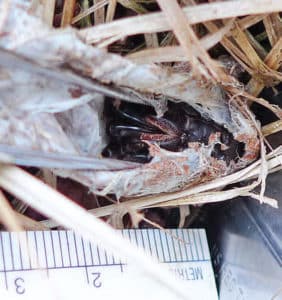~ by Katherine Brooks, Maria Mitchell Association ~

Nantucket is home to a few unusual spiders, including tarantulas, black widows, and even a new mysterious species. Unbeknownst to most, the brown recluse spider does not inhabit the island of Nantucket, but around 258 other species do. Supported by the Nantucket Biodiversity Initiative and other conservation groups, Andrew McKenna-Foster, Director of Natural Science at the Maria Mitchell Association (MMA), found and collected over 6,000 spider specimens. Many of the specimens are in the collections at the Hinchman House Natural Science Museum and many more were donated by the MMA to the Museum of Comparative Zoology at Harvard University.
From 2006-2009, McKenna-Foster collected spiders to update a historic species list compiled by spider expert James Emerton in 1929. Emerton identified around 170 different types of spiders on Nantucket. Updating the list required using a myriad of methods. These methods include the spider pit fall trap; sorting through leaf litter on the ground; picking spiders off of tree branches; beat sheets (shaking spiders out of trees onto a sheet for collection); aspirators (which suck up spiders); and the sweep net, which is the classic insect net that sweeps through grass.
From the collection efforts in 2006-2009, McKenna-Foster found a few spider species that were not recorded in 1929 list, like the purseweb spider (tarantula), which was found on both Tuckernuck and Nantucket. There are two species of the purseweb spider – in one species the male has red legs and the come out in July to look for females while the other species has black legged males, which come out in June to look for females. While the redlegged species is easier to find, neither species is well studied and there is still much to learn.
Another species discovered in the recent surveys is the Northern black widow (Latrodectus variolus). There are three types of black widow spiders in North America: the northern, southern, and western. The rarest is the northern black widow and so far the only population found near Nantucket is on Tuckernuck (and on Martha’s Vineyard). The western species has not been found on Nantucket, but two specimens of the southern species were found, both over 10 years ago — one at Stop and Shop in a package of grapes and one at Mill Hill in an electrical box. Both were most likely brought here accidentally.
One of the most interesting finds from the last census was an unidentified species of spider. Since then, the spider has been sent around to experts and was last on its way to China. There are around 40,000 identified species of spiders in the world, and the science community is going global to see if this unique looking spider could be added to that list. There have been two of these “mystery spiders” found, one at Ram Pasture and one at Squam Swamp. The investigation of this particular species of spider is ongoing.
Although spiders are often categorized as “creepy crawly” and often elicit screams, they are indicators of biodiversity in an ecosystem. Found from the tree canopy to the ground floor (and below), spiders are adaptors. Andrew McKenna-Foster, Director of Natural Science and the researcher who found Nantucket’s new spider species, calls spiders “the MacGyver of the animal world.” The volcanic island, Krakatoa, erupted in 1883 wiping out the island’s inhabitants completely – but the first living creature that scientists found on the island was a spider. This was most likely a young spider that “ballooned” onto the island from some other land mass on a long strand of silk. Many young spiders balloon away from where they were born to escape competing with their brothers and sisters for food. The resilience and adaptability of these creatures is quite amazing, and severely under studied. The 2006-2009 spider census on Nantucket created a platform for new avenues of research, illuminated how spider species are changing on the island, and established a new reference point that future scientists may use to assess changes.
If you are interested in learning more about spiders or insects on Nantucket, join the MMA for a Night Insect Field Trip on August 10 or visit the MMA’s historic spider collection at the Hinchman House Natural Science Museum located at 7 Milk Street.
The MMA was founded in 1902 to preserve the legacy of Maria Mitchell and to promote her belief in learning-by-doing. An astronomer and natural scientist, as well as an educator, Maria Mitchell shot to worldwide fame when she discovered a comet in 1847. For her discovery, she was awarded a gold medal from the King of Denmark – the first American and first woman to receive the honor. She served as the Professor of Astronomy and Mathematics at Vassar College from 1865 until 1888. Today, the MMA operates two observatories, a natural science museum, an aquarium, and the birthplace of Maria Mitchell. The MMA conducts scientific research, leads classes and workshops for people of all ages year-round, and welcomes thousands of visitors to its museums and observatories. For details, visit mariamitchell.org.



